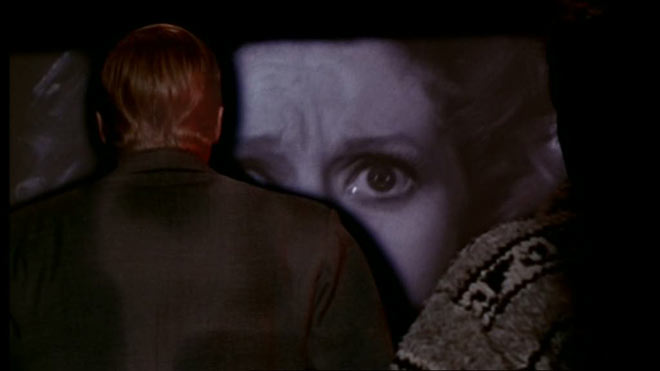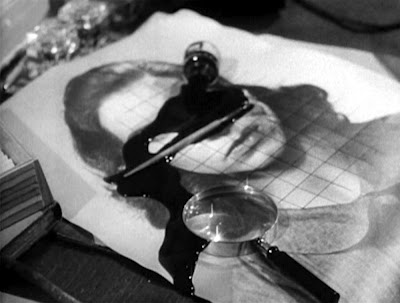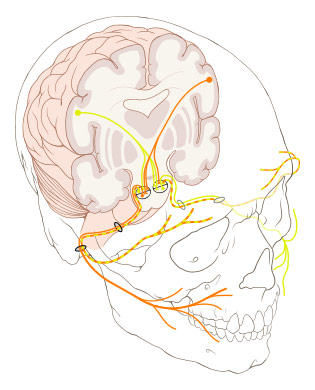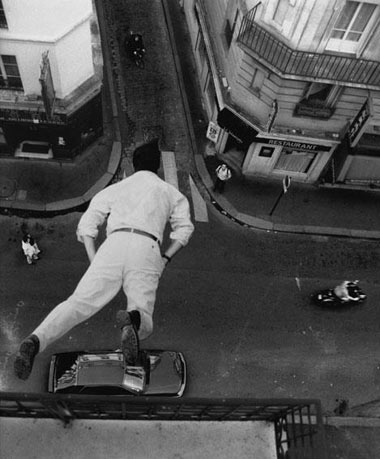neurosciences

A computational model is a surrogate version of something usually made on a computer. An example that most people are familiar with are the computational models used to predict the weather. If you know how low pressure and high pressure fronts interact, and you know where one is and how fast it is moving, you can program software to play the situation out in a simulation, predicting what will happen and how quickly. […]
If you know how the thalamus, hippocampus, amygdala, and cortex all work together, you can simulate how inputs into one structure might influence the others. In this case each brain structure would basically be a ‘black box’ that received input and produced output based on known data.
{ The Cellular Scale | Continue reading }
brain, neurosciences | May 23rd, 2012 3:22 pm

Meeting new people can be a delicate business. How do you make sure that people get a right impression of who you are and what you’re capable of? Many people therefore tend to keep things formal and are hesitant to brag about themselves. But recent research in the Journal for Social Psychological and Personality Science reveals that it is wise to actually show your best self when meeting new people. At least, when you want them to really get to know you.
{ United Academics | Continue reading }
Neuroscientists at NYU and Harvard have identified the neural systems involved in forming first impressions of others. […] Making sense of others in a social interaction is not easy—each new person we meet may be a source of ambiguous and complex information. However, when encountering someone for the first time, we are often quick to judge whether we like that person or not. In fact, previous research has shown that people make relatively accurate and persistent evaluations based on rapid observations of even less than half a minute.
{ eScienceNews | Continue reading }
related { Why First Impressions Are So Persistent }
painting { Marcus Harvey, Girl in Burka with Red Underwear II, 2007 }
guide, neurosciences, psychology, relationships | May 18th, 2012 1:37 pm

A good memory is typically seen as a powerful advantage, an aid to intelligence and socializing. But when experience is traumatic, this asset may become a serious liability, according to new research on survivors of the Rwandan genocide.
Researchers at the University of Basel in Switzerland studied a gene for a protein called PKCA, which is known to be involved in the encoding of emotional memories. […]
According to the study, the findings point to a “genetic link between the predisposition to build strong memory and the risk for post-traumatic stress disorder.”
The research also adds to increasing evidence that many “positive” genes also have a downside — and similarly, many “negative” ones have an upside. For example, one gene linked with a tendency for children to share treats with others is also linked to ADHD and later in life, promiscuity and addiction.
{ Time | Continue reading }
photo { Juergen Teller }
genes, memory | May 18th, 2012 5:44 am

Poltergeists are defined as paranormal, mischievous ghostly presences that appear to a select group of people. As paranormal entities, they are beyond investigation by rational scientific means. Or are they? Odd sensations, visions, felt presences, out-of-body experiences, etc. have all been explained by unusual brain activity. Hence, neuroscientists should consider that poltergeists exist in the mind of the perceiver, not as a physical reality in the external world.
A new paper by parapsychologist William G. Roll and colleagues reported on the case of a woman who experienced paranormal phenomenon after suffering a head injury. (…)
[After the head injury,] …the relationship with her first husband deteriorated because he insisted she was not the same person. According to her reports one night he tried to kill her. The anomalous phenomena began that night and have been intermittent since that time. Their intensity and frequency have increased during the last 2–3 years.
EEG recordings revealed chronically abnormal activity at a right temporal lobe electrode.
{ The Neurocritic | Continue reading }
brain, incidents, neurosciences, relationships | May 7th, 2012 11:54 am

Neuroscientists have uncovered the first evidence of a common genetic thread, which links together multiple senses in humans.
The new findings suggest our sense of touch is genetically intertwined with our sense of hearing; in practice this means if you’ve got a good sense of hearing, it’s highly likely you also have a high touch performance.
{ Cosmos | Continue reading }
neurosciences, noise and signals | May 4th, 2012 2:00 pm

Well-meaning friends and family members may suggest that you have a couple of drinks after living through a stressful event. A friend of mine had a bike accident recently that sent her over a car door and miraculously left her with only a few bruises. Having a couple of drinks immediately after this will of course dull her nerves, since ethanol is an anxiolytic. But is it really a good idea to get tipsy (or worse) after living through a stressful event?
lt’s well known that acute stress modulates memory in a powerful way. People who have lived through a traumatic event will often either have either perfect photographic memory of the event or partial or total amnesia. Untreated, exposure to a traumatic event can lead to post-traumatic stress disorder (PTSD), which causes long-term problems. There exist preventive treatments that, when applied immediately after the traumatic event, have been shown to decrease the likelihood of getting PTSD. This includes antagonists of adrenaline and NMDA receptors; this messes with the acquisition of memory.
Of course good ol’ beer will mess with the acquisition of memory; that’s why people get brownouts and blackouts. It is also an antagonist of NMDA receptors (among many other systemic effects). So given that alcohol is an anxiolytic and that it causes amnesia, it doesn’t seem such a stretch to think that having a beer right after very a stressful event (within the next, say, 6 hours) will decrease the likelihood of long-term negative consequences (say, developing a phobia of biking).
This is of course the sort of hypothesis that is very hard to get funding to test. We do know that PTSD sufferers frequently turn to alcohol after their trauma and that this negatively affects outcome. And drowning your sorrows is never the solution. To be clear, taking an anxiolytic and amnesiac acutely to avoid acquiring a potentially adverse memory of a traumatic event and taking it in a sustained way after the memory is consolidated to drown it out are two completely different things.
{ xcorr | Continue reading }
artwork { Joel Shapiro, Untitled, 1980 }
food, drinks, restaurants, memory, neurosciences | May 4th, 2012 6:00 am

From what I previously understood, people would ingest mushrooms, and if they were in a negative state of mind, they’d have a “bad trip.” If they were with friends, with other people tripping, they were more likely to have a “good trip.” Aspects of these trips seemed to include lots of visual and auditory hallucinations: “halos” glowing around light sources, warping colors, maybe some synesthesia.
So I just figured that magic mushrooms must hyper-activate the parts of the brain that perceive color and sound, to the point where people perceive things that aren’t even there.
However, recent research out of the U.K. says that, surprisingly, I’ve got it all backwards. (…)
Within a minute or two, the test subjects started to feel the effects of the psilocybin, and the researchers gave them fMRIs during their trips. Surprisingly to me, and to the scientists, brain activity and blood flow decreased by up to 20% during the influence of the drug, and these decreases were proportional to the reported intensity of the trip. (…) The thought behind this finding is that when people do shrooms, pathways in the brain that would normally restrict cognition are temporarily turned off, allowing people to cognate at higher levels than ever before. Some of these same cognition-restraining pathways are overactive in cases of depression, but I won’t go so far as to suggest shrooms as a treatment for depressive disorders.
{ Try Nerdy | Continue reading }
photo { Stefan Heyne }
brain, drugs, neurosciences | May 3rd, 2012 8:13 am

Brain neuroimaging studies continue to outline the structural and functional abnormalities in disorders of mood. A relatively consistent finding has been a reduced volume of the brain hippocampus in major depressive disorder. Studies of hippocampal volume in the less common bipolar disorder have been inconsistent–some studies have found reduced hippocampal volumes while others have not.
The hippocampus is an important brain region to understand in the mood disorders. The hippocampus has a key role in memory. Patients with mood disorders commonly display impairments in mood including deficitis in autobiographical memory. Unipolar depression appears to increase risk for later development of Alzheimer’s disease. Hippocampal volume reduction is a common finding in Alzheimer’s disease. (…)
Lithium is noted to have significant neuroprotective effects. (…) It is possible that bipolar patients treated with lithium may experience less hippocampal atrophy than those not treated with lithium.
{ Brain Posts | Continue reading }
charcoal on paper { Marius de Zayas, John Marin and Alfred Stieglitz, ca. 1912–13 }
brain, memory, neurosciences | May 2nd, 2012 7:25 am

David Eagleman, neuroscientist: Take the vast, unconscious, automated processes that run under the hood of conscious awareness. We have discovered that the large majority of the brain’s activity takes place at this low level. The conscious part – the “me” that flickers to life when you wake up in the morning – is only a tiny bit of the operations. This understanding has given us a better understanding of the complex multiplicity that makes a person. A person is not a single entity of a single mind: a human is built of several parts, all of which compete to steer the ship of state. As a consequence, people are nuanced, complicated, contradictory. We act in ways that are sometimes difficult to detect by simple introspection. (…)
Raymond Tallis, former professor of geriatric medicine: [You] present us as more helpless, ignorant and zombie-like than is compatible with the kinds of lives we actually live and, what’s more, with doing brain science.
{ Guardian | Continue reading }
related { How free is the will? }
photo { Heiner Luepke }
ideas, neurosciences | April 30th, 2012 11:04 am

When you see a person’s face, how do you go about combining his or her facial features to make a decision about who that person is? Most current theories of face perception assert that the ability to recognize a human face is not simply the result of an independent analysis of individual features, but instead involves a holistic coding of the relationships among features. This coding is thought to enhance people’s ability to recognize a face beyond what would be expected if each feature were shown in isolation. In the study reported here, we explicitly tested this idea by comparing human performance on facial-feature integration with that of an optimal Bayesian integrator.
Contrary to the predictions of most current notions of face perception, our findings showed that human observers integrate facial features in a manner that is no better than would be predicted by their ability to use each individual feature when shown in isolation. That is, a face is perceived no better than the sum of its individual parts.
{ SAGE | Continue reading }
faces, neurosciences | April 23rd, 2012 6:56 am

According to what some call the strong definition of free will, articulated by René Descartes in the 17th century, you are free if, under identical circumstances, you could have acted otherwise. Identical circumstances refer to not only the same external conditions but also the same brain states. (…)
Contrast this strong notion of freedom with a more pragmatic conception called compatibilism, the dominant view in biological, psychological, legal and medical circles. You are free if you can follow your own desires and preferences. A long-term smoker who wants to quit but who lights up again and again is not free. His desire is thwarted by his addiction. Under this definition, few of us are completely free. (…)
Consider an experiment that ends with a 90 percent chance of an electron being here and a 10 percent chance of it being over there. If the experiment were repeated 1,000 times, on about 900 trials, give or take a few, the electron would be here; otherwise, it would be over there. Yet this statistical outcome does not ordain where the electron will be on the next trial. Albert Einstein could never reconcile himself to this random aspect of nature. (…)
This experiment was conceived and carried out in the early 1980s by Benjamin Libet, a neuropsychologist at the University of California, San Francisco. (…)
Intuitively, the sequence of events that leads to a voluntary act must be as follows: You decide to raise your hand; your brain communicates that intention to the neurons responsible for planning and executing hand movements; and those neurons relay the appropriate commands to the motor neurons that contract the arm muscles. But Libet was not convinced. Wasn’t it more likely that the mind and the brain acted simultaneously or even that the brain acted before the mind did?
Libet set out to determine the timing of a mental event, a person’s deliberate decision, and to compare that with the timing of a physical event, the onset of the readiness potential after that decision. (…)
The results told an unambiguous story, which was bolstered by later experiments. The beginning of the readiness potential precedes the conscious decision to move by at least half a second and often by much longer. The brain acts before the mind decides! This discovery was a complete reversal of the deeply held intuition of mental causation.
{ Scientific American | Continue reading }
photo { Tabitha Soren }
ideas, neurosciences, photogs | April 13th, 2012 5:00 am

Among the most surprising discoveries about memory has been the realisation that remembering a past event is not like picking a DVD off the shelf and playing it back. Remembering involves a process of reconstruction. We store assorted features of an event as representations that are distributed around the brain.
In simple terms, visual features are represented near the back of the brain in the areas specialised for visual processing; sounds in auditory processing regions close to the ears; and smells in the olfactory system that lies behind the nose.
To experience the rich, vivid “re-living” of a past event that is remembering, we fit these features together into a representation of what took place.
A lot of stuff happens in our lifetimes, and so it makes sense that our brains would have evolved some efficient memory strategies. We don’t try to remember every single event in its entirety. Instead, we store the elements of an event, and put them together in different ways to make different memories. The downside is that similar events that share a number of features may be more difficult to remember.
Our experiment was designed to investigate this effect.
{ Guardian | Continue reading }
artwork { Sougwen Chung | Thanks Tim }
memory | April 12th, 2012 10:12 am

Scientists report that they have mapped the physical architecture of intelligence in the brain. Theirs is one of the largest and most comprehensive analyses so far of the brain structures vital to general intelligence and to specific aspects of intellectual functioning, such as verbal comprehension and working memory. (…)
“We found that general intelligence depends on a remarkably circumscribed neural system,” Barbey said. “Several brain regions, and the connections between them, were most important for general intelligence.”
These structures are located primarily within the left prefrontal cortex (behind the forehead), left temporal cortex (behind the ear) and left parietal cortex (at the top rear of the head) and in “white matter association tracts” that connect them.
The researchers also found that brain regions for planning, self-control and other aspects of executive function overlap to a significant extent with regions vital to general intelligence.
The study provides new evidence that intelligence relies not on one brain region or even the brain as a whole, Barbey said, but involves specific brain areas working together in a coordinated fashion.
{ University of Illinois | Continue reading }
brain, neurosciences | April 10th, 2012 2:02 pm

How to actually be good at rote memorization. A group of psychologists decided to help the kids out by examining the optimal duration for studying a particular item. (…)
Subjects who avoided the longest (16s) and shortest (1s) durations retained more information when testeed after 5 minutes and when tested after 2 days. (…)
Performance was much better for intermediate (e.g., 4 s) presentation durations.
I bring up this study not because it’s crucial for our education system, but because in the future every part of our lives will be designed based on this type of research. Advertisements, online dating profiles, and all manner of printed instructions will be optimized for the perfect exposure length.
{ peer-reviewed by my neurons | Continue reading }
memory, psychology | April 9th, 2012 12:20 pm

A new approach to fMRI scanning offers a three-dimensional look at brain activation.
fMRI is already a 3D technique, of course, but in the case of the cerebral cortex - which is what the great majority of neuroscientists are most interested in - the 3D data are effectively just 2D images folded up in space. (…)
In a new paper, Minnesota neuroscientists Olman et al say that they’ve given fMRI a third dimension.
{ Neuroskeptic | Continue reading }
related { functional MRI (fMRI) is an MRI procedure that measures brain activity by detecting associated changes in blood flow. }
health, neurosciences, technology | March 30th, 2012 1:53 pm

When we watch a show on stage, TV or movie, we do the little trick of suspending disbelief. We do not believe what we are experiencing but we treat the content ‘as if we believed it’ for the duration of the show. We can re-enter that disbelieved experience if we choose, as if it were a memory of something that actually happened. The show can have lasting effects on how we view the world and interact with others. It has all the hallmarks of a really personal experience except that we know it is fictional. (…) What is the difference between this sort of memory and what we call false-memory? It is only the believe that the events remembered actually happened to us.
According to a recent paper, belief and memory are separate processes. We can have: memories that we believe were events, memories that we do not believe were events, beliefs about events that we do not remember, and events that we neither believe nor remember. (…)
The authors found that belief is easier to modify than memory. It is easier to create a false belief in a subject that it is to create a false memory. And likewise, it is easier to destroy a false belief than a false memory.
{ Thoughts on thoughts | Continue reading }
memory, neurosciences | March 26th, 2012 2:19 pm

Several studies suggest that memories can be pharmaceutically dampened. For example, researchers recently showed that a drug called ZIP causes cocaine-addicted rats to forget the locations where they had regularly been receiving cocaine. Other drugs, already tested in humans, may ease the emotional pain associated with memories of traumatic events.
Many are alarmed by the prospect of pharmaceutical memory manipulation. In this brief comment, I argue that these fears are overblown. Thoughtful regulation may someday be appropriate, but excessive hand-wringing now over the ethics of tampering with memory could stall research into promising methods of preventing and treating post-traumatic stress.
{ SSRN | Continue reading }
photo { Nigel Shafran, Moonflower, 1990 }
drugs, memory, neurosciences, photogs | March 23rd, 2012 1:58 pm

Neuroscientists know that the brain contains some 100 billion neurons and that the neurons are joined together via an estimated quadrillion (one million billion) connections. It’s through those links that the brain does the remarkable work of learning and storing memory. Yet scientists have never mapped that whole web of neural contact, known as the connectome. It would be as if doctors knew about each of our bones in isolation but had never seen an entire skeleton. The sheer complexity of the connectome has put such a map out of reach until now.
{ Discover | Continue reading }
related { Is a project to map the brain’s full communications network worth the money? }
illustration { Trevor Brown }
brain, neurosciences | March 23rd, 2012 12:01 pm

People with autism have a greater than normal capacity for processing information even from rapid presentations and are better able to detect information defined as ‘critical’, according to a study published today in the ‘Journal of Abnormal Psychology’. The research may help to explain the apparently higher than average prevalence of people with autism spectrum disorders in the IT industry.
{ Wellcome Trust | Continue reading }
related { Learning best when you rest: Sleeping after processing new info most effective, new study shows }
photos { Mark Steinmetz }
neurosciences | March 23rd, 2012 10:07 am

A team of researchers that includes a USC scientist has methodically demonstrated that a face’s features or constituents – more than the face per se – are the key to recognizing a person.
Their study, which goes against the common belief that brains process faces “holistically,” appears this month in Psychological Science.
In addition to shedding light on the way the brain functions, these results may help scientists understand rare facial recognition disorders.
{ EurekAlert | Continue reading }
photo { Thomas Prior }
faces, neurosciences, photogs | March 19th, 2012 3:18 pm






















